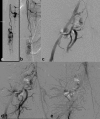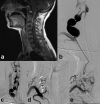Paraspinal arteriovenous fistula: Stuttgart classification based on experience and a review of the literature
- PMID: 29376731
- PMCID: PMC6209468
- DOI: 10.1259/bjr.20170337
Paraspinal arteriovenous fistula: Stuttgart classification based on experience and a review of the literature
Abstract
The term "paraspinal arteriovenous shunts" (PAVSs) summarizes an inhomogeneous variety of rare vascular disorders. PAVSs have been observed as congenital or acquired lesions. The clinical course of PAVSs may be asymptomatic or present with life-threatening symptoms. Based on a collection of individual cases from three institutions and a literature evaluation, we propose the following classification: PAVSs that are part of a genetic syndrome are separated from "isolated" PAVSs. Isolated PAVSs are subdivided into "acquired", "traumatic" and "congenital" without an identifiable genetic hereditary disorder. The subgroups are differentiated by the route of venous drainage, being exclusively extraspinal or involving intraspinal veins. PAVSs associated to a genetic syndrome may either have a metameric link or occur together with a systemic genetic disorder. Again extra-vs intraspinal venous drainage is differentiated. The indication for treatment is based on individual circumstances (e.g. myelon compression, vascular bruit, high volume output cardiac failure). Most PAVSs can be treated by endovascular means using detachable coils, liquid embolic agents or stents and derivates.
Figures





References
-
- Foix CH, Alajouanine T. La myélite nécrotique subaigue. Rev Neurol 1926; 2: 1–42.
Publication types
MeSH terms
LinkOut - more resources
Full Text Sources
Other Literature Sources

